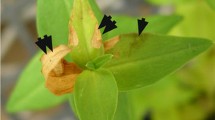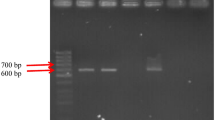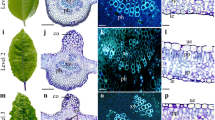Conclusion
Our evidence suggests that the tip necrosis disease in passionfruit on the New South Wales North Coast results from infection of the commercial plants with CMV. These plants already contain a mild strain of PWV through the accreditation scheme. it is probable that the tip necrosis disease seen in the field and that produced experimentally resulted from a dual infection with CMV and PWV, because neither virus alone causes such a severe disease (8) and there was no indication of the presence of the tip blighting strain of PWV. Also, experimental inoculation of CMV to passionfruit seedlings infected with PWV produces a severe disease syndrome that includes tip necrosis (8).
The reasons for the occurrence of CMV and the tip necrosis disease during 1984 is not known. The virus has a wide host range including cultivated and weed species. It is also efficiently transmitted in a nonpersistent manner by many aphid species. The incidence of CMV in other crops in New South Wales was also higher during 1984 (R.D. Pares, unpublished information).
Similar content being viewed by others
References
Greber, R.S. (1966) — Passionfruit woodiness virus as the cause of vine tip blight disease. Queensland Journal of Agricultural and Animal Science, 23: 533–538.
Kaper, J.M., and Waterworth, H.E. (1981) — Cucumoviruses. Handbook of plant virus infections. Comparative diagnosis. Elsevier/North Holland Press, ed. E. Kurstak: 257–332.
Milne, R.C. and Luisoni, E. (1975) — Rapid high resolution immune electron microscopy of plant viruses. Virology 68: 270–274.
Pares, R.D., and Martin, A.B. (1984) — Passionfruit viruses in New South Wales. New South Wales Department of, Biology Branch Plant Disease Survey (1982–83): 22–23.
Pares, R.D., Martin, A.B., and Morrison, W. (1983) — Rhabdovirus-like particles in naturally infected Passiflora edulls Sims. Australasian Plant Pathology 12: 51–52.
Peasley, D. and Fitzeil, R.D. (1981) — Passionfruit industry benefits through scion wood scheme. Agricultural Gazette, N.S. W., 92: 5–8.
Taylor, R.H. and Greber, R.S. (1973) — Passionfruit woodiness virus. C.M.I./A.A.B. Descriptions Plant Viruses No. 122.
Taylor, R.H., and Kimble, K.A. (1964) — Two unrelated viruses which cause woodiness of passionfruit (Passiflora edulis Sims). Australasian Journal of Agricultural Research, 15: 560–570.
Tolin, S.A. (1977) — Cucumovirus (Cucumber Mosaic Virus). The Atlas of Insect and Plant Viruses, Academic Press, N.Y. ed. K. Maramorosch: 303–309.
Author information
Authors and Affiliations
Rights and permissions
About this article
Cite this article
Pares, R.D., Martin, A.B. & Fitzell, R.D. Virus-induced tip necrosis of passionfruit Passiflora edulis Sims). Australasian Plant Pathology 14, 76–78 (1985). https://doi.org/10.1071/APP9850076
Issue Date:
DOI: https://doi.org/10.1071/APP9850076




